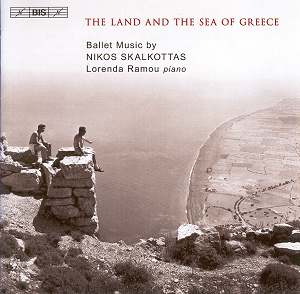There is a little pull-out
brochure that goes into the booklet
of this CD which indicates that this
is the sixteenth disc in the remarkable
and on-going Skalkottas cycle from Bis.
The series has been sponsored by the
Hellenic Ministry of Culture. There
was a time when one Skalkottas disc
alone was cause for celebration but
now we are deep into his style and have
gained a fantastic all-round picture
of his short composing career. The series
started well before the centenary and
it’s good to see that it is continuing.
In fact we are even more blest because
some of the pieces in these versions
for solo piano have been heard on previous
discs in their vivid orchestral colours.
Skalkottas was a terrific orchestrator,
not surprisingly for a man who earned
his living in an orchestral pit in Athens.
I should say at the
outset that Skalkottas was a musical
schizophrenic. There are works like
the phenomenal Third Piano Concerto
- an atonal work lasting well over an
hour (Bis 1364). Then again there are
the 36 Greek Dances for orchestra (Bis
1333/1334) and other works inspired
by Greek culture and Greek music. The
pieces on this present CD mostly fall
into the latter category although ‘The
Maiden and Death’ at times lurch on
the boundary between the two.
It might be useful,
especially if you have been collecting
them, to know where these piano versions
may be found on earlier orchestral discs
in the series. Let’s start with ‘The
Land and the Sea of Greece’. This, like
most of the pieces on the recording,
is a late work and appears here as a
six movement suite. For this ballet
Skalkottas collaborated with Polyxemi
Mathay, pictured within the booklet
alongside the composer. The opening
salvo entitled ‘The Harvest’ in a rather
earnest waltz time sets a happy mood.
This is followed by another waltz ‘The
Sowing’ couched in gentle modality.
This offers the antithesis of the first
piece but both help to make a charming
start to the CD. The orchestrated version,
now called ‘Four Images’, dates from
1949 and is on Bis CD 1384 conducted
by Byron Fidetzis. Oddly enough you
can also find it on Bis SACD 1484 played
by the BBCSO conducted by Nikos Christadoulou.
The two unused movements, ‘The Trawl’
(or ‘Trawler’) and ‘The Dance of the
Waves’ were incorporated in another
suite entitled ‘The Sea’ - an eleven
movement work available on the same
disc. Curiously enough the orchestration
is so colourful that the piano version,
especially under the formidable hands
of Lorenda Ramou, can often seem to
have more visceral power.
The second ballet for
piano is ‘Island Images’. This is a
six movement work written during the
dark days of World War Two especially
for a student, Aleka Mazaraki-Katseli
and her diploma ballet exam. This was
apparently orchestrated but at present
the whereabouts of the score are not
known. Its titles are again nationalistic
with a heavy-footed ‘Greek Dance’ and,
following it, ‘Sunday in Church - Feast’,
‘The Trawler’ (again) and ‘Sea Waves’.
All depict various scenes from the life
of the coastal dwellers.
‘The Maiden and Death’
is a harmonically more daring piece
as heard right from the start in the
opening chords. Even so it is largely
diatonic and never tough at least not
in the sense encountered in the string
quartets. It consists of seven movements
simply listed with Italian speed markings.
The booklet offers us a useful resumé
of the somewhat convoluted plot. The
brilliantly orchestrated version can
be heard on Bis CD 1014 played by the
Iceland SO under Christadoulou. The
excellent booklet notes by Yannis Samprovalakis
describe it as "a ballet suite
after a well-known Greek folk tune";
not well known to me I’m afraid.
‘Acheron’ is the valley
of Death. This gloomy procession is
most impressive as is the following
‘Echo’ a little piece also recorded
by Nikolaos Samaltanos on Bis 1464.
I am not quite sure how it came about
that Bis decided on the luxury of recording
certain pieces a second time but with
this piece it’s quite interesting that
Ramou finds much more mystery in it
than Samaltanos and is over one minute
longer in its execution. She is aided
by a first class and immediate but realistic
acoustic.
So time to draw breath
and sum up. Most of these works can
be heard in other formats and guises
elsewhere in the series. Does that matter?
To me, No. These piano versions are
the composer’s first thoughts. They
are generally the ones which were first
aired in the initial excitement of the
ballet projects he was involved with
and which were apparently so well received.
In his spare time, sometimes to a commission,
and no doubt burning the midnight oil
having been playing all evening, he
would set about the marvellous orchestrations.
One might perhaps call these works after-thoughts,
so these piano originals are well worth
hearing and worth adding to your collection.
This is especially so in the hands of
Lorenda Ramou who has both grace and
power coupled with a clear rhythmic
pulse.
I must comment on the
booklet notes and their accompanying
black and white photos. With this disc
the essay is ideal. With some in the
series there has been so much gobbledygook
and technical detail that the print
became so tiny one has almost literally
needed a microscope to read it. They
are now clear both in type face and
in what they have to say and are also
well translated for a change.
Gary Higginson


